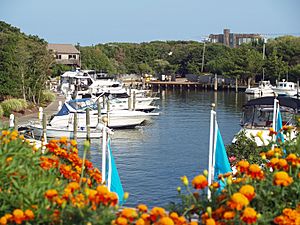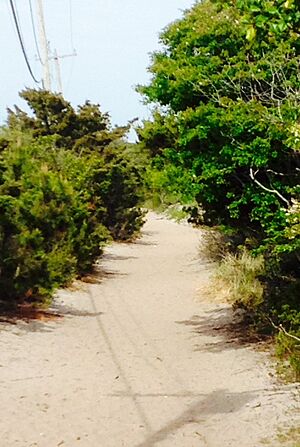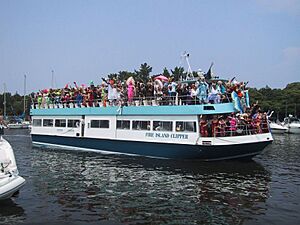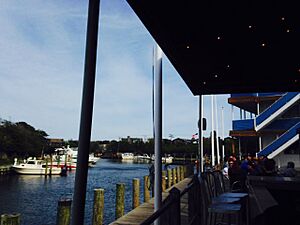Fire Island Pines, New York facts for kids
Quick facts for kids
Fire Island Pines
|
|
|---|---|

The marina from the west side shops area looking east
|
|
| Nicknames:
The Pines, Pines, FIP
|
|
| Country | United States |
| State | New York |
| County | Suffolk |
| Lots first sold | 1952 |
| Population
(2004)
|
|
| • Total | 12 (full-time)/2,500 to 3,000(seasonal) |
| Time zone | UTC−05:00 (Eastern Time Zone) |
| • Summer (DST) | UTC−04:00 |
| ZIP Code |
11782
|
| Area code(s) | 631, 934 |
Fire Island Pines (often called The Pines, Pines, or FIP) is a small community. It is a hamlet in Suffolk County, New York, United States. The Pines is on Fire Island, a barrier island that is separate from Long Island by the Great South Bay.
Fire Island Pines and the nearby Cherry Grove are well-known vacation spots. Many people visit these areas for their relaxed and welcoming atmosphere. The island has been a popular place for vacationers since the 1920s and 1930s.
The Pines has the most expensive homes on Fire Island. It has about 600 houses and a 100-unit apartment complex. The area is about one square mile. It also has two-thirds of all the swimming pools on Fire Island. During the summer, its population grows to between 2,500 and 3,000 people. In 2004, only 12 people lived there all year round.
People get around on foot using boardwalks. If you need to carry groceries, people often use red wagons. The popular Radio Flyer wagons are a common sight.
Contents
History of Fire Island Pines
Fire Island Pines gets its name from the scrub pine trees there. Legend says these trees started growing after a ship carrying Christmas trees and holly sank off the coast in the late 1800s.
The Pines was first home to a Coast Guard station built in 1876. It was known as Lone Hill Saving Station. The Home Guardian Company bought the land in 1924. The "harbor" is where all the shops and businesses are. It has docks for boats, the passenger ferry, and freight operations.
In the 1960s, a dance club called the Sandpiper opened. Today, it is known as the Pavilion.
Fires in the Pines
There have been two big fires in the main business area of Fire Island Pines. The first fire happened on May 31, 1959. After this fire, John B. Whyte bought the burned hotel to rebuild it.
On November 14, 2011, another large fire destroyed the Pavilion. This included the businesses inside it. The building that burned had been built in 1980. Forty-three fire companies from Long Island helped fight the fire. About 400 firefighters worked in shifts all night to put out the blaze.
Developers and Property Owners
The Smadbecks' Vision
Plans for developing the area began in 1952. Warren and Arthur Smadbeck, from the Home Guardian Company, planned to sell 122 lots. They also wanted to build a private harbor for boats and a large dock. The Smadbecks had sold over 700,000 lots across the country. They bought this property from the Sammis family. The Sammis family had owned most of Fire Island since 1855.
The basic design of the Pines created by the Smadbecks is still seen today. This includes the Botel, which was a simple place for people to stay if they docked their boats in the harbor.
Some of the first people to own property here were famous. These included Pola Negri, Xavier Cugat, Mary Martin, and Joan McCracken. A 15-year-old Jane Fonda even taught dance classes there.
Peggy Fears' Contributions
Peggy Fears, a Broadway performer, found Lone Hill while visiting a nearby Fire Island community. Fears built the first yacht club. Part of her construction was a hotel made of cinder blocks, which is still standing. She invested $10,000 and bought an inlet on Great South Bay. By 1959, she had paid off her property, which was then worth $350,000.
The look of Fire Island Pines changed after the Botel and yacht club buildings burned in 1959. Fears rebuilt the Botel. In 1966, she sold her share to John B. Whyte.
John B. Whyte's Influence
Former model John B. Whyte helped make the Pines a popular vacation spot. He bought the rebuilt Botel Pines and Dunes Yacht Club in the 1960s. The Botel, also known as The Hotel Ciel for a time, is still the main hotel in the Pines.
Whyte made changes to welcome more visitors. He owned most of the businesses in the Pines. He created a fun social schedule. This included "Low Tea" (drinks at the Blue Whale from 5 pm to 8 pm). Then came "High Tea" (drinks at the Pavilion from 8 pm to 10 pm). After that, people enjoyed dancing at the Pavilion. All these places were owned by Whyte.
Famous visitors in the 1960s included Hedy Lamarr, Betty Grable, and Zachary Scott.
New Owners Over Time
In 2003, John B. Whyte decided to sell his businesses. He sold them to Eric von Kuersteiner for $9 million. Von Kuersteiner had been visiting the Pines since the late 1980s.
Later, in 2009, Matt Blesso, Andrew Kirtzman, and Seth Weissman formed a group called FIP Ventures.
In January 2015, most of the commercial properties were bought by Ian Reisner. This included the Pavilion and Blue Whale. P. J. McAteer, another business owner, joined the new company, Outpost Pines. He added his businesses like Sip & Twirl and Pines Pizza. McAteer now runs the harbor businesses.
Life in the Pines
While Fire Island has a small year-round population, it gets very busy in the summer. Especially on weekends, the population grows a lot. In the Pines, large houses are often shared by many people. A four-bedroom house might have eight people staying there at once. The community is known for being a lively place for many different people. Some call it "Chelsea with sand," referring to a lively neighborhood in Manhattan.
Many exciting events and fundraisers happen during the summer. Some of the biggest events are the Fire Island Dance Festival, Invasion, Pines Party, and Ascension. The Fire Island Dance Festival helps Dancers Responding to AIDS. This is a program of Broadway Cares/Equity Fights AIDS.
The Invasion of the Pines is a fun parade held every year on July 4. It celebrates a time when a performer named Terry Warren was refused service. Performers from Cherry Grove arrive by ferry and parade through the Pines. They then return to Cherry Grove, celebrating their visit.
Pines Party is an all-night dance party held on the beach each July. It used to be a fundraiser called Morning Party. This party helps organizations like the Stonewall Community Foundation. This foundation helps people in need. It also helps the Fire Island Pines Property Owners Association Charitable Foundation. This foundation uses money to improve common areas.
Von Kuersteiner started Ascension Weekend in 2006. This is a three-day event that brings many visitors to the Pines in August. It has featured famous DJs like Freemasons.
The Fund in the Sun Foundation was created in 2006 because of Ascension. This charity has given over $750,000 to many charities. These include the Hetrick-Martin Institute and The Trevor Project.
The music group The Village People recorded a song about Fire Island Pines. It is called Fire Island.
Getting Around Fire Island Pines
Fire Island Pines can only be reached by water. Most people use a passenger ferry or a private water taxi. There is also a small marina for boats. There are no private cars in this part of Fire Island. Police and service vehicles are sometimes seen on the beach. The Pines has no paved roads. Houses and the beach are reached by walking on wooden boardwalks.
Sayville Ferry Service
You can get to Fire Island Pines using the Sayville Ferry Service. The ferry leaves from Sayville, New York, across the Great South Bay. The Long Island Rail Road connects Sayville to New York City.
If you take the train to Sayville, you can use a shuttle van or taxi to get to the ferry. You can also walk or bike the mile and a half distance. If you drive, you can park in large parking lots across from the ferry dock.
Fire Island Water Taxi
Visitors who drive can park at the Robert Moses State Park "Field Five" parking lot. After reaching the Fire Island Lighthouse, the Fire Island Water Taxi can take you to the Pines. A water taxi also provides short rides along the coast of Fire Island. The cost and schedule for the taxi change depending on the season.
Notable People
- Harold Baer Jr., lived here
- Robin Byrd, lives here
- Sam Champion, lived here
- David Geffen, lived here
- Horace Gifford, lived here
- Dennis Kenney, lives here
- Calvin Klein, lived here
- Joan McCracken, early resident
- Tommy Tune
Images for kids
See also
 In Spanish: Fire Island Pines para niños
In Spanish: Fire Island Pines para niños







